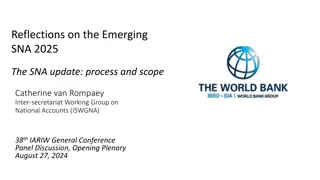
Prolog Language Fundamentals
Learn about the fundamentals of Prolog language including data types, program structure, mathematical and logical operations, and read/write functions. Explore how Prolog supports data types like integers, reals, chars, strings, and symbols, along with the program structure consisting of domains, data base, predicates, clauses, and goals. Dive into mathematical operations such as addition, subtraction, multiplication, division, and remainder, as well as logical operations like greater than, less than, equal to, not equal, greater or equal, and less than or equal. Discover how to use read and write functions to interact with variables of different types in Prolog programming.
Download Presentation

Please find below an Image/Link to download the presentation.
The content on the website is provided AS IS for your information and personal use only. It may not be sold, licensed, or shared on other websites without obtaining consent from the author. If you encounter any issues during the download, it is possible that the publisher has removed the file from their server.
You are allowed to download the files provided on this website for personal or commercial use, subject to the condition that they are used lawfully. All files are the property of their respective owners.
The content on the website is provided AS IS for your information and personal use only. It may not be sold, licensed, or shared on other websites without obtaining consent from the author.
E N D
Presentation Transcript
Prolog language lec2 Lec2 By MSC.Noor Hassan
1. Data type. 2. Program structure. 3. Read and write functions. 4. Arithmetic and logical operation.
1. data type Prolog supports the following data type to define program entries. 1. Integer: to define numerical value like 1, 20, 0,-3,-50, ect. 2. Real: to define the decimal value like 2.4, 3.0, 5,-2.67, ect. 3. Char: to define single character, the character can be of type small letter or capital letter or even of type integer under one condition it must be surrounded by single quota. For example, a , C , 123 . 4. string : to define a sequence of character like good i.e define word or statement entries the string must be surrounded by double quota for example computer , 134 , a . The string can be of any length and type. 5. Symbol: anther type of data type to define single character or sequence of character but it must begin with small letter and don t surround with single quota or double quota.
program structure Prolog program structure consists of five segments, not all of them must appear in each program. The following segment must be included in each program predicates, clauses, and goal. 1. Domains: define global parameter used in the program. I= integer C= char S = string R = real
Data base: define internal data base generated by the program Database Greater (integer) 3. Predicates: define rule and fact used in the program. Predicates Mark(symbol,integer). 4. Clauses: define the body of the program.. For the above predicates the clauses portion may contain Mark (a, 20). 5.Goal: can be internal or external, internal goal written after clauses portion , external goal supported by the prolog compiler if the program syntax is correct This portion contains the rule that drive the program execution.
mathematical and logical operation a .mathematical operation: operation symbol addition + subtraction - multiplication * Integer part of division div Remainder of division mod
B .logical operation Operation symbol Greater > Less than < Equal = Not equal <> Greater or equal >= Less than or equal <=
Read and write function Read function: readint(Var) : read integer variable. Readchar(Var) : read character variable. Readreal(Var) : read read (decimal) variable. Readln(Var) : read string. Write function Write(Var) : write variable of any type.
Example 1: write prolog program to read integer value and print it. Domains I = integer Predicates print. Clauses Print:- write ( please read integer number ), readint(X), write( you read ,X). Goal Print. Output: Please read integer number 4 You read 4
Example2: write prolog program that take two integer input us integer and print the greater. Domains I = integer Predicates Greater ( i,i) Clauses Greater(X,Y):- X>Y,write( the greater is ,X). Greater(X,Y):- write ( the greater is ,Y). Goal Greater(4,3). Output: The greater is 4
H.W: 1. write prolog program that read any phrase then print it. 2.write prolog program that read an integer number then print it after multiplying it by any other integer like 5.






















